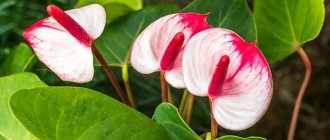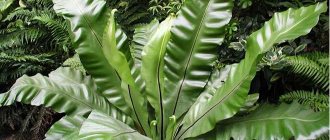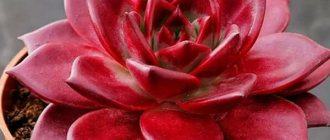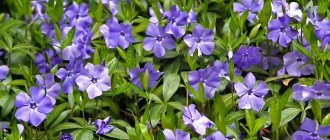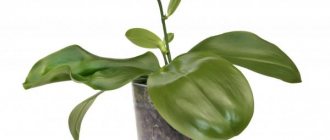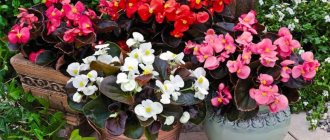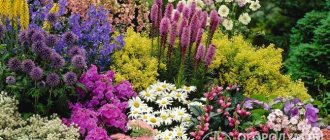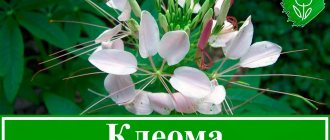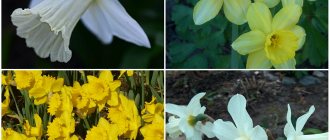Oncidium is the most beautiful and popular representative of the Orchid family. There are several types of this epiphyte, which differ from each other not only in the shade of the buds , but also in the color of the leaves.
Knowing how to choose a plant and how to care for it, you can grow an incredibly beautiful flower that will decorate your room for many years. what oncidium looks like in the photo.
Description of the plant
One of the varieties of orchids is Oncidium. The flower is divided into a variety of species, differing in the shade of buds and leaves . If we talk about the natural habitat of oncidium, then this is almost the whole world. Some plants represent the tropics of South and Central America, others grow on mountain tops, enjoying the coolness, and still others represent savannas and semi-deserts.
Each type of oncidium has its own external features, by which the plant can be distinguished from one another. Some species resemble irises in appearance in terms of the type of flower, leaves and stem. A distinctive feature of other varieties is the roots hanging from the pot.
The leaves and peduncles of different plant species also differ from each other. As for the flowers, they all grow in the same color range : from brown to yellow and orange. The structure of the buds and their shape are very similar, and the size is almost the same.
Only after blooming do they begin to exude a delicate and pleasant aroma. Flowering occurs several times a year. The duration of this period is individual, because it will be influenced by the living conditions of the plant. If you cut a flower and place it in a vase, it can please the eye for about three weeks.
Oncidium crispum
Oncidium curly
It is notable for its large buds, long peduncle with a branch at the top.
The petals are colored in several shades: the upper part is light or dark brown, the center is yellow with red spots.
When cut, the flowers last for 2–3 weeks, retaining their natural aroma.
The plant is actively used by breeders to produce hybrids with enlarged petals.
Variety of species
More than 600 species of oncidium are considered known, and cultivation is carried out with several of them . In an apartment, you can safely grow hybrid varieties, because they are unpretentious.
Important! The most popular is oncidium yellow. It gained its fame thanks to its lemon-colored buds.
There are these types:
Oncidium sweet sugar
A distinctive feature of the flower is its small size. Together with the flowers, its height does not even reach 40 cm. It looks like bulbs, from which long green leaves emerge . The buds are colored yellow. Each of them has a diameter of about 2.5 cm.
Sharry baby
This species is considered a hybrid and emits a honey-chocolate smell. Small flowers are formed on the plant, colored red, deep purple, or brown . Each inflorescence has 8-10 flowers. The hybrid reaches a height of 68 cm.
Oncidium twinkle
This species is also a hybrid and is quite often found in homes. Its dimensions are miniature - up to 10 cm. However, oncidium twinkle produces many flowers of yellow, scarlet, pink , and white. Exudes vanilla aroma. There will be no problems caring for this plant.
Oncidium varicosum
The flower has bright green leaves and is distinguished by a large number of inflorescences that produce up to hundreds of buds. The plant blooms for almost two months from late summer to mid-autumn.
Oncidium limminghei
The flower is small in size, the peduncle is only 9-10 cm in length, and begins to grow from the base in autumn or summer. Only one flower is formed on one stem .
It can bloom constantly. As soon as the predecessor falls off, a new one immediately blooms. The flowers are small, only 4 cm in diameter, but, based on the small size of the leaves and stems, they look large.
Sinuous (oncidium flexuosum)
The leaves of this species grow spreadingly and have a bright green hue. The flowers are large compared to greenery, although they reach only 2.5-3 cm in diameter .
There are several flowers, and they form a paniculate inflorescence. The buds are of a golden hue , which turns brown towards the base. Flowering occurs from July to August.
Beautiful (oncidium splendidum)
The peculiarity of this plant is its straight and hard leaves of a purple-greenish tone . They are boat shaped. One plant often has 17-19 bright yellow flowers. The bud reaches 6-8 cm in diameter.
Oncidium tigrinum
The flowers of this species are large. Their diameter is 6-7 cm . They are yellow in color with brownish dots.
Oncidium papilio
From each flat pseudobulb grow olive-toned leaves with a scarlet marble pattern. Based on the name, it is clear that in appearance it resembles a brown-red butterfly with yellow spots , which has long mustaches.
Oncidium lanceanum
In this type of plant, the upper side of the leaf is lighter than the lower side. The plates are very thick, fleshy , along the edges of which you can see brown specks. Each peduncle produces several green-yellow flowers that emit a pleasant scent.
Oncidium sphacelatum
The plant has hard leaves, sharp at the ends and quite long . The flowers are small in size - 2-3 cm in diameter, united by a paniculate inflorescence. They are mostly brown and have lemon spots. The formation of buds occurs at the end of the year , and the flowers bloom until the end of winter.
Curly (oncidium cricpum)
This type of plant is very beautiful, distinguished by brown-red petals , the edges of which are slightly jagged. The flowers are two-tone, the lower part is painted soft brown, and the upper part is yellow with scarlet splashes. The peduncle reaches 28-30 cm in length , compact, although it branches.
Bird-billed (oncidium ornithorhynchum)
This plant captivates the eye: small buds, the diameter of which reaches only 2 cm . Blooms in pink, purple, white with lemon yellow areas.
The plant received such an interesting name due to its pointed sepals, which bend over the column like a bird’s beak. The petals are narrow at the edges and have a jagged edge . Bird-billed oncidium, like popcorn, is perfect for growing indoors.
Oncidium Twinkle
Oncidium Twinkle
Oncidium Twinkle is a hybrid whose parents are Oncidium cheirophorum and Oncidium ornithorhynchum.
Depending on the color option there are:
- Oncidium Twinkle 'White Fantasy' – white;
- Oncidium Twinkle 'Fragrance Fantasy' – pale yellow;
- Oncidium Twinkle 'Red Fantasy' – soft pink.
It is compact, the size of the inflorescence rarely reaches 10 cm. It blooms for up to three weeks with small pink, bright red, white or yellow inflorescences.
From 30 to 50 buds are formed on one peduncle. In the morning, the flowers emit a delicate, sweet aroma.
Transplantation after purchase and during further growing season
Plants are replanted only if necessary. This could be, for example, the case when the entire container is filled with roots and the plant can no longer fully develop.
It is best to plant the flower in a wide pot, which is filled with special soil for orchids. You can also make the composition yourself: combine pieces of bark , sand from the river bank, peat, sphagnum moss and charcoal.
Basic rules for transplantation:
- First of all, we take out the flower from the previous pot.
- We thoroughly clean the roots from bad soil and place the plant in water for 15 minutes . The liquid should be at medium temperature. We remove rotten roots, cutting them down to living tissue. Apply a fungicide solution where cuts appear.
- To prevent disease, in the future the soil for the flower should be calcined in the oven or kept in boiling water.
- We put a layer of drainage in a new pot and place the substrate on it.
- Next, place the flower in a pot so that there is enough space for the pseudobulbs. The oldest one should be near the edge of the container.
- We fill the resulting voids with soil so that the roots are completely under it. The bulbs are located above the surface.
- At the end of planting, you need to check that the plant sits tightly in the pot and does not fall out of it. For greater stability, you can use a rope and a stick .
In addition to the traditional method of breeding orchids, they can be grown using tree bark, attaching the plant to it with sphagnum moss.
Landing
To plant an orchid, choose light and airy soil with good air permeability . The best option for comfortable growth is a mixture of natural pine bark, perlite and charcoal. Ready-made mixtures for orchids are also available.
The Oncidum orchid does not need a transparent pot , its roots do not need it. To plant it, choose wide plastic or ceramic pots . If you need to replant a large perennial, then select an unglazed ceramic container for it. Compact varieties of orchids can be planted using block culture, on pieces of cork bark.
Oncidium feels good on the block.
ATTENTION! You need to be more careful when transplanting Oncidums, as they react poorly to transplantation. The procedure should be performed only as necessary if the previous composition of the soil has become unusable.
Transplantation is performed every 3 years . We replant during active growth of shoots. If you need to transplant an adult orchid, you can combine it with dividing the bush by planting a small shoot into a separate bush.
The transplant technology is as follows:
- Water the orchid with warm water, wait 15 minutes, wait until the roots soften;
- Carefully remove the orchid from the pot, squeeze it on all sides, shake it, remove it, without violating the integrity of the substrate;
- We look through the roots, remove soft rotten roots, clean them from the substrate;
- When replanting, we take into account the growth pattern of the orchid. Oncidum is a pyramidal orchid and the shoots here grow only in one direction, so they plant it not in the center, but in one direction, moving the bulbs to one edge of the pot ;
- We place drainage in advance before planting, trying not to deepen the base of the pseudobulb so that there is sufficient ventilation;
- Only the roots go into the ground, the bulbs and rhizomes lie on the surface of the soil;
- Upon request, the plant is fixed with pegs so that the stem does not break;
- The transplanted perennial is shaded and the water supply is stopped for a week.
Growing conditions
Temperature
Care at home involves maintaining temperature conditions . Depending on the type, indicators may vary.
Temperature for oncidium:
- Heat-loving species, whose natural habitat is tropical forests, live well at a maximum temperature of 30 degrees . The minimum readings should be within 15 degrees.
- Oncidiums from temperate latitudes. They live in the mountains and foothills. In the summer, a good temperature for them will be 20-22 degrees, and in the autumn-winter period the plants will survive at 13-15 degrees.
- Cold-loving species. In nature, they grow in forested mountain areas. In the summer they grow well at 21-22 degrees, and in the cold season the temperature should not fall below 7-8 degrees.
Important! In the room where oncidiums grow, temperature fluctuations should not exceed 5 degrees.
At the moment, there are practically no pure species of oncidium on sale. Most often you purchase hybrids, since such plants are most suitable for growing at home.
They can grow well all year long if the room temperature ranges from 15 to 27 degrees. However, do not forget that unsuitable conditions can destroy the flower .
Air humidity
As for humidity, this indicator plays a small role for the growth of an orchid. Oncidium develops well if the air humidity is 70%, and also tolerates levels of 35% . If in summer it is very hot even indoors and there is no air conditioning, or it does not help, you can spray the leaves with water to cool the plant.
The same measures are carried out in winter, when due to the use of heating the air in the room becomes too dry . If the air humidity is less than 35%, the leaves may dry out. An electronic humidifier will save the situation. And you can also use a stand with wet sand or expanded clay.
Spraying with heated water has a positive effect on the flower , however, if the temperature drops below 18 degrees, then measures to moisten the plant must be completed. Oncidium needs systematic ventilation of the room , otherwise fungal infection of plants may become more active.
Lighting
The described type of orchid needs increased lighting . The plant should be provided with constant bright light, however, it should not be exposed to direct sunlight.
Important! The lack of light directly affects the condition of the plant's leaves. If the plates become darker and denser, then this is a sign of what is needed. And, conversely, if the leaves lighten and acquire red specks, this means that the rays have burned them.
When the flower has enough sun, its plates are beautiful in appearance and have a bright green tint. It is quite possible that leaves can look good even in minimal lighting . But, in this case, the flower sacrifices flowering, so don’t expect buds. For proper development in winter, it is recommended to install a fluorescent lamp near the flowerpot.
The soil
, which can be found in a garden store, is perfect as a soil for the growth of oncidium You can also prepare the soil yourself, the main thing is to know what is included in its composition for ideal orchid flowering.
To do this you will need to combine peat, pine bark, charcoal, sphagnum moss . When planting a plant in a pot, you need to ensure that the stem is near the edge, and the rest of the space is occupied by new shoots. For planting, it is best to choose a wide container.
This video talks about the features of caring for Oncidium.
Oncidium splendidum
Oncidium Beautiful
Each of the plant's pseudobulbs produces only 1 thickened leaf. The leaf blades are green with a grayish tint and covered with a pattern of rare purple dashes.
It usually blooms in the winter season. From the base of the pseudobulb grows a peduncle bearing about 20 buds. They all bloom almost simultaneously.
Yellow-green elongated petals and sepals are slightly curved at the edges, covered with dark brown spots. The large lip is colored bright yellow.
Good care guarantees lush flowering. Each time the number of colors increases and can reach more than 7 dozen.
Features of care
Watering
Moistening the soil of a flower also has a number of features. Watering is directly affected by the stage of growth and development of the plant. As soon as the pseudobulb appears, the orchid should be provided with good systematic watering. The same activities continue until the sprout appears.
There must be holes in the bottom of the pot to allow excess liquid to escape. Otherwise, the water will stagnate and the roots will most likely rot. It is better to water the orchid with settled liquid at medium temperature.
The soil should never be too dry, otherwise it will have a bad effect on the root system . Watering stops when a fresh pseudobulb appears. It is these conditions that contribute to the growth of the young peduncle.
When it begins to grow, irrigation should again be included in the daily care of the plant. If too many pseudobulbs appear on a flower, it will not be able to fully grow, because there will be no strength for it.
Top dressing
Plant nutrition is provided for the growth of new shoots. Fertilizers are added to the water and soil until new pseudobulls appear . The resumption of feeding occurs with the appearance of a peduncle.
to stop fertilizing after the orchid has finished blooming . One has only to add a little fertilizer to the soil, and it will immediately appear on the plant.
It is best to purchase specialized mixtures intended for orchids. The fertilizer should be diluted in a smaller proportion than specified by the manufacturer. Both leaves and roots should be fed .
Trimming
There is no need to trim oncidium. If the peduncle begins to wither and turn yellow, then it should be removed, leaving a small stump in its place . Leave the green peduncle in the pot, because new flowers may appear on it.
Transfer
This video shows how to properly replant an Oncidium orchid.
The plant is very sensitive when such manipulations are carried out with it.
As a result, it is better not to engage in transplantation .
You need to resort to this procedure only when the soil has become unsuitable or too many roots have appeared. In this case, it is simply necessary to change the substrate. Advice! When replanting, place a drainage layer on the bottom of the new pot.
Oncidium sharp baby
Oncidium Sheri baby
Pseudobulbs are ovoid, flattened, up to 6.4 cm wide and 9 cm high.
The leaves are leathery, lanceolate, pointed at the ends, up to 45 cm long, 5 cm wide.
The roots are thin, covered with velamen.
The inflorescence is erect or slightly drooping, multi-flowered, bearing several dozen flowers.
The flowers are red and white, fragrant, the smell is associated with vanilla chocolate. The diameter of the flowers is about 3.8 cm.
Temperature group - from moderate to warm. Under favorable conditions, plants can bloom up to twice a year.
Diseases and pests
Oncidium, like orchids, is often susceptible to pest invasion. It could be a scale insect, a mealybug or a fairly common mite. If you notice a foreign body on a flower , you should remove it with cotton wool soaked in soapy water or alcohol.
Next, you need to treat the flower with a special anti-pest preparation. This is actellite or actara. Instead of industrial products, you can use folk remedies - prepare a garlic or onion infusion. To do this, add a spoonful of chopped vegetables to a glass of water and mix well. You need to leave the mixture for a day and then apply it.
Important! Often housewives do not know why oncidium dries out the peduncle. This problem can be caused by improper placement of leaves, which slow down its growth.
In addition to pests, the flower can be affected by fungal or bacterial rot . Due to waterlogging, the roots begin to rot. The same thing happens when placing oncidium in a draft or wind.
If you notice brown spots on the leaves of a flower, this means that the plant has been affected by bacterial rot. should be immediately removed and the flower moved to a warm, ventilated room. You can also treat the plant with a fungicide.
Oncidium tigrinum
Oncidium tiger
Plants are found in areas of Jalisco and Michoacan in Mexico at altitudes of 1600 to 2500 meters.
Tiger oncidium is noticeable by the variegated color of its flowers: yellow petals are strewn with small brown spots. The diameter of each bud is 7–8 cm. It blooms only in winter.
How to create a root mass in a plant without roots
In order for the plant to develop roots, it must be provided with greenhouse conditions . If you do everything correctly, you will achieve the desired effect in a short time .
As a greenhouse at home you can use:
- aquarium;
- cut plastic bottle or carboy.
A greenhouse allows you to create conditions for oncidium in which it is accustomed to growing in nature. And you should also provide the flower with diffused lighting , high air temperature, and suitable humidity conditions. The greenhouse is placed under the sun or a lamp, excluding direct light from it.
Oncidium yellow
Oncidium Yellow
Characterized by unpretentiousness and rich flowering.
This species has lemon yellow flowers and lush blooms. From 10 to 25 buds are formed on one peduncle, which open simultaneously and have bright red spots.
Blooms for about 1 month. After cutting, the plant remains attractive for up to 2 weeks.
How does a flower reproduce?
A flower growing at home reproduces well by bulbs or by dividing a bush . Both methods are simple and fairly easy.
Dividing the bush
It is advisable to carry out the event if more than seven pseudobulbs have appeared, because a flower on which there are three pseudobulbs can already grow and develop . Division is done by cutting the bush with a disinfected tool.
After this, the sections are treated with crushed coal . Each cut piece of the plant must be planted in dry soil. The shoots do not need to be watered for 10 days so that the cut points do not begin to rot. Transplantation should be carried out in early spring.
Reproduction methods
The best way to propagate an adult Oncidum orchid is to divide the bush . The optimal period for the procedure is February or March:
- For an adult orchid, we leave 3 large bulbs in each division and plant the rest;
- We free the roots from the soil substrate;
- Using a sharp sterile blade, we cut off the stem that is attached to the bulb;
- Sprinkle the cut area with crushed coal, and then plant it in the prepared substrate.
ADVICE! To prevent root rot from forming in areas of fresh cuts, watering is stopped for 12 days after separation.
Oncidium cheirophorum
Oncidium Ruciformis
Described by the German botanist Heinrich Gustav Reichenbach in 1852.
Nicaragua, Colombia. Epiphytes. Mountain tropical forests at altitudes from 1000 to 2500 meters above sea level. Often found on large tree branches illuminated by the sun.
Pseudobulbs are 1.2 - 3 cm in height, densely spaced, rounded, laterally compressed. Wrinkled with age.
The leaves are green, thin, up to 15 cm in length. The number of leaves at the top of the pseudobulbs is from 1 to 2.
The peduncle is multi-flowered, arched, paniculate, up to 30 cm in length. Formed at the base of the lower leaves on mature pseudobulbs.
The flowers are fragrant, yellow, up to 1.5 cm in diameter. The aroma differs among different geographical races.
Flowering begins in autumn.
Prevention of various problems
Prevention consists of regular proper care of the oncidium orchid . Maintain the resting phase, prevent drafts, overheating, and apply fertilizing on time.
You can learn about other types of orchids from our separate materials. Among them: Bulbophyllum, Cymbidium, Liodoro, Miltonia, Cattleya, Vanilla, Cambria, Philadelphia, Sogo and Brassia.
Oncidium limminghei
Oncidium limminga
A small peduncle up to 10 cm long and produces only 1 flower with burgundy-brown upper petals and yellow lower ones. The blooming flower reaches 4 cm.
The difference between this species is the possibility of year-round flowering: after the bud withers, a new peduncle begins to grow in the same place.
Oncidium papilio
Oncidium moth
Trinidad, Venezuela, Colombia, Ecuador and Peru. In Venezuela, this plant is found in the northern provinces of Carabobo, Lara, Merida, Miranda and Trujillo at altitudes of 800–1200 m above sea level.
It grows in a relatively high dense forest in Guatopo at an altitude of 460 m. This species is quite widespread, but is not found in the lower, drier parts of coastal forests.
Pseudobulbs are 3.7–5.0 cm high. They are oval to round, closely growing, flattened, wrinkled, often strewn with dirty red spots with darker specks.
At the top of each pseudobulb grows a single leaf 15–23 cm long. The leaves are erect, dull green, with veins or purple-red spots on both sides of the leaf blade.
The flower is located high above the foliage and looks like a flying moth. The buds are yellow in the middle, bright scarlet around the perimeter.
Having released another new flower, the peduncle continues to grow, so there is no need to cut it off after flowering, since it will still form flowers over the next few years.
Flowering period: can bloom all year, less often blooms in January.
Oncidium flexuosum
Oncidium sinuous
It is found naturally in Brazil, Argentina, Uruguay and Paraguay, where it grows lithophically on coastal cliffs at an altitude of 500 to 800 meters above sea level.
It blooms from July to August with yellow inflorescences (diameter no more than 1.5 cm). The buds are collected in a panicle inflorescence, the leaves are colored light green.
Peduncles hanging down. There are from 60 to 100 flowers per peduncle.
Synonyms for this type of orchid are: Ampliglossum flexuosum, Coppensia flexuosa, Epidendrum lineatum, Oncidium haematochrysum and Oncidium megalopterum.
Orchid in men's lives
Orchids not only patronize their owners, they love their owners no less. It is believed that the orchid symbolizes a man as a leader. This gift is for prudent and rational men who strive for the top in everything. The Chinese call the orchid “Lan” - this word is used when it is necessary to emphasize masculine qualities. It sounds like a synonym for “strong”, “smart” and “worthy”.
Interesting! It is believed that the vanilla scent of Oncidium Twinkle adds passion to the bouquet. The Latin word Orchidaceae roughly means “come from God.”
